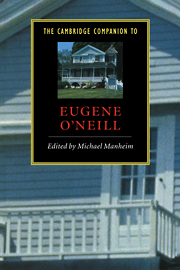Book contents
- Frontmatter
- Introduction
- 1 Celebrant of loss: Eugene O'Neill 1888-1953
- 2 O'Neill's philosophical and literary paragons
- 3 O'Neill and the theatre of his time
- 4 From trial to triumph: the early plays
- 5 The middle plays
- 6 The late plays
- 7 Notable American stage productions
- 8 O'Neill on screen
- 9 O'Neill's America: the strange interlude between the wars
- 10 O'Neill's African and Irish-Americans: stereotypes or “faithful realism”?
- 11 O'Neill's female characters
- 12 "A tale of possessors self-dispossessed"
- 13 Trying to write the family play: autobiography and the dramatic imagination
- 14 The stature of Long Day's Journey Into Night
- 15 O'Neill and the cult of sincerity
- 16 O'Neill criticism
- Select bibliography of full-length works
- Index
12 - "A tale of possessors self-dispossessed"
Published online by Cambridge University Press: 28 May 2006
- Frontmatter
- Introduction
- 1 Celebrant of loss: Eugene O'Neill 1888-1953
- 2 O'Neill's philosophical and literary paragons
- 3 O'Neill and the theatre of his time
- 4 From trial to triumph: the early plays
- 5 The middle plays
- 6 The late plays
- 7 Notable American stage productions
- 8 O'Neill on screen
- 9 O'Neill's America: the strange interlude between the wars
- 10 O'Neill's African and Irish-Americans: stereotypes or “faithful realism”?
- 11 O'Neill's female characters
- 12 "A tale of possessors self-dispossessed"
- 13 Trying to write the family play: autobiography and the dramatic imagination
- 14 The stature of Long Day's Journey Into Night
- 15 O'Neill and the cult of sincerity
- 16 O'Neill criticism
- Select bibliography of full-length works
- Index
Summary
That Eugene O'Neill could not complete the historical cycle as it was designed is one of the greatest losses the drama in any time has sustained. Goethe's comment on Marlowe's Dr. Faustus, “How greatly it was planned,” has more relevance to A Tale of Possessors, Self-dispossessed. It was a work of astonishing scope and scale. Theresa Helburn rightly called it a comédie humaine. Nothing in the drama, except Shakespeare's two cycles on British history, could have been set beside it. The two plays that have survived reveal something of the power of life that beat in it, but they show only vestiges of what its full plan realized would have provided: a prophetic epitome for the course of American destiny.
(Travis Bogard, Contour in Time, p. 369)O'Neill's own detailed record of his living and writing from 1924 to 1943, the Work Diary, now part of the O'Neill collection at Yale, makes possible the following account of the vast Cycle project: how it was conceived and developed, and how it eventually ended. Although much manuscript material relating to the plays was destroyed, their plots can be reconstructed from scenarios and other notes also preserved at Yale. Outlines of all the plays in the nine-play Cycle are given here in the sequence of their conception as part of the series. They are followed by a summary of the four plays outlined by O'Neill in October and November 1940 to replace plays one and two, actually written between 1935 and 1937, but later destroyed. The four gave the plan its final form - a Cycle of eleven plays.
- Type
- Chapter
- Information
- The Cambridge Companion to Eugene O'Neill , pp. 178 - 191Publisher: Cambridge University PressPrint publication year: 1998



